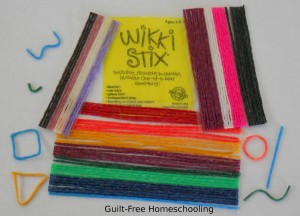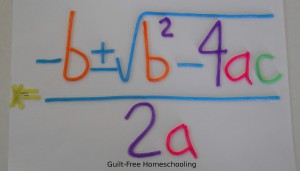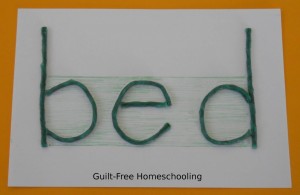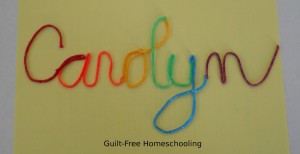Does your hands-on learner need a new challenge? Try using Wikki Stix as manipulatives. If you’re not familiar with them, Wikki Stix are thin, wax-coated strings that resemble pipe cleaners or chenille sticks, except that they aren’t fuzzy, and they will stick to each other. The sticking-together aspect makes them wonderful learning tools, because they will also stay where you put them, and you can put them just about anywhere: table, window, cookie sheet, poster board — this list can go on forever. Stick them on the glass patio door or the refrigerator door for a kinesthetic, standing-up lesson activity. The Stix are waxy, but leave very little residue, and it is easily cleaned away. Bonus tip: If they accidentally get dropped on the floor and collect a few dust bunnies, cereal crumbs, and pet hair, holding them under running water and air-drying will restore them back to good-as-new condition.
Wikki Stix come in a variety of colors, including neons, and I have also found knock-off brands — check your favorite stores for craft or school supplies. (Wikki Stix brand have a unique bumpy texture that is both tactilely and visually interesting.) Use them full length (8″ long) or cut them into small lengths with scissors, and start creating. Let your students make letters and words, make numbers and math problems, or just have fun making all sorts of fun art projects.
Your older students can combine letters and numbers into the latest complicated formula they are trying to memorize. Yes, Wikki Stix are a fantastic tactile and visual method for color-coding the components of a mathematic or scientific formula! The tactile process of assembling a complex formula from Wikki Stix, complete with color-coding, is a very subtle way of memorizing — once your student has finished this project, he may find he has it committed to memory without even trying!
How can Wikki Stix help with lessons? First of all, let your students use the Wikki Stix as their learning aids — the kids will learn much more if they do it themselves, than if Mom just shows them what she’s made for them. The extended process of building each letter, number, or shape keeps your student’s fingers involved in the lesson, and the child’s brain has to think the process through from a different perspective than if he was just writing normally with a pencil. (By all means, do help the child who needs help getting started with this activity, but encourage his independence once he’s understood what to do.)
Color-code certain parts of words (vowels, phonics patterns, prefixes & suffixes, etc.) or math problems (use different colors for positive and negative numbers, or x-components in one color and y-components in another color).
Make Wikki Stix flashcards with spelling words, vocabulary words, or formulas on a sheet of cardstock and insert the finished cards into plastic page sleeves. Works for spelling, phonics, math, science, geography, history, foreign language, etc. Using this method to “write” troublesome spelling or vocabulary words allows the student to focus on getting each letter and each syllable in the correct order.
Make geometric shapes on flashcards, just like the idea above, and use them for identification and recall drills, or use the shapes as tactile manipulatives for math problems. For a bigger challenge, let your students try identifying the shapes by touch alone, by feeling them with their eyes closed.
Cursive writing can be tricky to practice, especially for those who are just learning it. Stick several Wikki Stix together end-to-end and shape them into cursive writing. Using Wikki Stix for cursive slows the process down considerably and allows the writer to put the lines exactly where they need to go! (and no pesky eraser crumbs!)







 Guilt-Free Homeschooling is the creation of Carolyn Morrison and her daughter, Jennifer Leonhard. After serious disappointments with public school, Carolyn spent the next 11 years homeschooling her two children, from elementary to high school graduation and college admission. Refusing to force new homeschooling families to re-invent the wheel, Carolyn and Jennifer now share their encouragement, support, tips, and tricks, filling their blog with "all the answers we were looking for as a new-to-homeschooling family" and making this website a valuable resource for parents, not just a daily journal. Guilt-Free Homeschooling -- Equipping Parents for Homeschooling Success!
Guilt-Free Homeschooling is the creation of Carolyn Morrison and her daughter, Jennifer Leonhard. After serious disappointments with public school, Carolyn spent the next 11 years homeschooling her two children, from elementary to high school graduation and college admission. Refusing to force new homeschooling families to re-invent the wheel, Carolyn and Jennifer now share their encouragement, support, tips, and tricks, filling their blog with "all the answers we were looking for as a new-to-homeschooling family" and making this website a valuable resource for parents, not just a daily journal. Guilt-Free Homeschooling -- Equipping Parents for Homeschooling Success!

Speak Your Mind